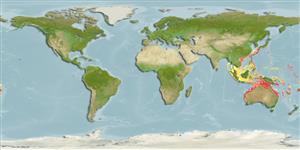Common names from other countries
>
Callionymiformes (Dragonets) >
Callionymidae (Dragonets)
Etymology: Synchiropus: Greek, syn, symphysis = grown together + Greek, cheir = hand + Greek, pous = foot (Ref. 45335).
Environment: milieu / climate zone / depth range / distribution range
Ecologia
marinhas demersal; intervalo de profundidade 23 - 75 m (Ref. 86942). Tropical
Western Central Pacific: northwestern Australia and New Caledonia.
Tamanho / Peso / Idade
Maturity: Lm ? range ? - ? cm
Max length : 15.0 cm TL macho/indeterminado; (Ref. 3132)
Espinhos dorsais (total) : 4; Raios dorsais (total) : 8; Raios anais : 7. Head and body light grey, ventrally white, sides with small red blotches and streaks. First dorsal fin yellow or grey, with vertical yellow bars, white spots and streaks edged with black. Second dorsal fin light grey with horizontal yellow and white streaks on posterior half. Caudal fin with 2 wide, vertical, dark grey bars. Anal fin distally black. Preopercular spine with 4 to 11 small antrorse serrae on its dorsal margin and an antrorse spine at its base. First dorsal fin at least twice as high as second dorsal fin. Caudal fin in males without filaments (Ref 42832).
Lives on trawling grounds, often found on sand or rubble bottoms.
Ciclo de vida ou comportamento de acasalamento
Maturities | Reprodução | Spawnings | Egg(s) | Fecundities | Larvas
Allen, G.R. and R. Swainston, 1988. The marine fishes of north-western Australia: a field guide for anglers and divers. Western Australian Museum, Perth. 201 p. (Ref. 3132)
Status na Lista Vermelha da UICN (Ref. 130435)
CITES (Ref. 128078)
Not Evaluated
Ameaça para os humanos
Harmless
Uso pelos humanos
Ferramentas
Relatórios especiais
Baixar XML
Fontes da internet
Estimates based on models
Preferred temperature (Ref.
115969): 20.8 - 26.5, mean 24.5 (based on 38 cells).
Índice de diversidade filogenética (Ref.
82804): PD
50 = 0.5000 [Uniqueness, from 0.5 = low to 2.0 = high].
Bayesian length-weight: a=0.01148 (0.00455 - 0.02896), b=2.92 (2.70 - 3.14), in cm Total Length, based on LWR estimates for this (Sub)family-body shape (Ref.
93245).
Nível Trófico (Ref.
69278): 3.5 ±0.4 se; based on size and trophs of closest relatives
Resiliência (Ref.
120179): Elevada, tempo mínimo de duplicação da população menor que 15 meses (Preliminary K or Fecundity.).
Fishing Vulnerability (Ref.
59153): Low vulnerability (10 of 100).
